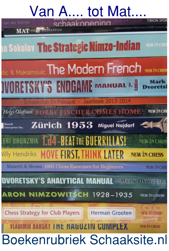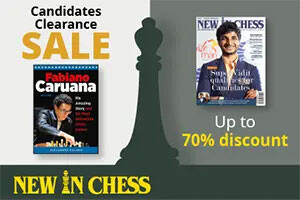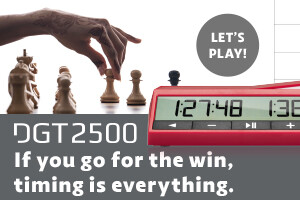Gelfand: Positional Decision-making In Chess

Schaaksite besteedt graag aandacht aan boeken. Daarvoor hebben wij op dit moment zes recensenten, van uiteenlopende speelsterkte. Bij het ene boek zijn we blij als dat wordt gerecenseerd door een grootmeester, bij het andere boek zijn we blij als het wordt gerecenseerd door een modale clubschaker. Wij streven ernaar regelmatig een recensie te plaatsen, zo veel mogelijk op dinsdag of vrijdag. Vandaag de eerste recensie van grootmeester Sipke Ernst.
Afgelopen juni verscheen Positional Decision-Making In Chess, een samenwerkingsverband tussen Jacob Aagaard en topgrootmeester Boris Gelfand. Aanvankelijk was dit boek alleen in hardcover verkrijgbaar, maar sinds deze week is het dan eindelijk ook aan te schaffen in paperback. Een goed moment voor een recensie, want die verdient het boek absoluut.
Het gebeurt namelijk niet zo vaak dat ik een schaakboek doorwerk zonder dat ik daarbij uitstapjes naar andere boeken maak. Eigenlijk lees ik de meeste schaakboeken maar voor 30% en dan meestal ook nog zonder een schaakbord te gebruiken. Een beetje plaatjes kijken zeg maar. Dit boek is daarop echter een grote uitzondering : ik heb het keurig met bord en stukken van voor naar achteren doorgewerkt, en daarbij hoogstwaarschijnlijk nog best veel geleerd ook!

Op het boek staat Gelfand als enige auteur vermeld, maar Jacob Aagaard, een sterke Deense grootmeester en schaaktrainer, tevens eigenaar van uitgever Quality Chess, heeft een aandeel aan dit project (‘project’, want er schijnt nog een aantal vervolgdelen te komen, hoera!) dat niet moet worden onderschat. De rolverdeling voor dit project was in grote lijnen als volgt: Gelfand liet het partijmateriaal voor dit boek zien aan Aagaard, die op zijn beurt op Socratesiaanse wijze door middel van het stellen van de juiste vragen de observaties van Gelfand inzichtelijk heeft gemaakt en opgeschreven.
Het boek heeft vijf hoofdstukken, waarvan het eerste hoofdstuk kan worden gezien als een inleiding. In dat eerste hoofdstuk, ‘Playing in the style of Abika Rubinstein’, vertelt Gelfand dat hij zich als jeugdspeler erg voelde aangetrokken tot de positionele speelstijl van de Poolse topspeler dankzij een kennismaking met het nauwelijks te verkrijgen boek Rubinstein van Razuvaev en Murakhveri. Aan de hand van enkele partijen wordt duidelijk waar Gelfand’s grote bewondering voor Rubinstein vandaan komt en waarom juist Rubinstein zijn grote voorbeeld is.
De opzet in de hoofdstukken twee tot en met vijf is dat Gelfand eerst één of meerdere modelpartijen van Rubinstein behandelt om een onderwerp in te leiden, om vervolgens enkele van zijn eigen partijen uitvoerig onder de loep te nemen. Zo’n analyse van een partij neemt al gauw twintig pagina’s in beslag, maar toch verveelt het geen moment. Dit komt vooral doordat de analyses veelal verbaal zijn, ondersteund met korte varianten ter illustratie. De vele diagrammen maken het boek een erg prettige leeservaring. Het commentaar bij de partijen is instructief, en dit is wat het boek ook zo ontzettend goed maakt. Een voorbeeldje uit hoofdstuk twee dat gaat over ‘the Squeeze’, oftewel hoe maak je uit niets iets.
Gelfand-Kasparov, Linares 1994
“This is a good moment to take stock. White’s plan was to exchange his opponent’s good bishop and consolidate. He has entirely succeeded in this, as well as managing to put his pieces in dream positions. The question is what to do next. An important consideration here is to think of what Black wants to do. Basically, he would like to exchange all the rooks. At least, if I was Black here, this is what I would try to do: make sure I had only one weakness and then try to hold. I would probably start with . . . g6, bur it is also interesting to do it directly: …Rxc1 22.Rxc1 Rc8 23.Rxc8+ Bxc8 24.Qc2 Qd8 25. Nh5 Ned7 and Black holds. So I wanted to do something concrete to improve on this line and prevent …g6.
21. g4!?
A concrete idea based on sound positional foundations. First of all, White can allow himself to play in this way because his opponent is not very active and because the situation in the centre is entirely stable. There are of course long-term issues with the king’s safety, which we will see later in the game. But at this point in the game it is dear chat the positives outweigh the negatives. The main idea behind pushing the g-pawn is to attack the d5-pawn. Nimrowitsch said that isolated d-pawns should be blockaded; Bene Larsen said they should be taken! Having satisfied Nimzowitsch, I am now aspiring to please Larsen as well… An interesting question is whether White’s advantage would be enough to win the game without playing g2-g4. It is really hard to say. It is far easier to answer the question by saying that his advantage is bigger with the push.”
Het boek staat vol met dit soort pareltjes van advies. Hoogtepunt van het boek was voor mij hoofdstuk drie, dat handelt over ruimtevoordeel. Het hoofdstuk begint met een theoretische uitleg over wat ruimtevoordeel precies inhoudt. Het mooiste voorbeeld van ruimtevoordeel als beslissend strategisch concept vind ik de partij Gelfand-Campora, Izmir 1994. Hieronder een fragment uit die partij.
“White’s advantage is not up for debate, but he still needs to find a way to break through: especially as the position is rather closed at the moment. Obviously we want to squeeze Black on both flanks, but we should not do this without having a clear plan about how we can improve our position. the next stage in this game is to exchange the rooks and the queens. Having done this Black will have no counterplat whatsoever allowing me to play on both flanks, which is necessary to exploit the advantage. Going through Rubinstein’s games you will find this theme countless times. Someone else told me that the same principle exists in military strategy. It is quite logical: if you are weaker, you want to narrow the battlefield as much as possible and have as few contact points as possible. Both in war and in chess we see this concept played out in the fortress strategy. In this position Black might be able to defend his position on one rank, but s soon as the front becomes wide, he collapses. After the exchanges White will be able to open the game without fearing that something dangerous will slip through the cracks. Also, as White cannot gain control of the c-file, it makes sense to prevent Black from getting it.
23. Tc1 Dd7 24. Tfc2 Tac7 25. Pd3 Kf8 26. Txc7
Apparently it is all but obvious to some other grandmasters that White should exchange the heavy artillery in this position, but I did not spend a lot of time on this decision at all. The danger of doing this is of course thst Black could be able to set up a fortress and the heavy pieces would be needed to break it. Making such a decision at the board depends a lot on what you believe about the position. I was sure that I could break any attempt and therefore went for it without much hesitation. I should add that it is of course too far into the future to consider which type of fortress Black will try to set up. This is a moment to go with your feeling. I believed that White would win this ending and there were a lot of upsides to it. And I always play according to my beliefs. At the end of the day it is not a matter of life and death; nor is it the right moment to find ultimate solutions.”
Met name hoe Gelfand tegen het gebruik van engines aankijkt is een terugkerend thema binnen dit boek, en het leert ons iets hoe topgrootmeesters waarschijnlijk erg flexibel omgaan met de suggesties van de sterkste programma’s. Twee quotes:
”Extremely often the computer will suggest moves that no human would consider. And when we do not feel it delivers us a clear understanding of why this move is good, I cannot see that it makes sense to follow its recommendations”. (p.199)
“Chess is a game and the practical dimension should not be underestimated. The evaluation of pleasant/unpleasant is often more useful than +0.73 or whatever the engine is saying. How difficult is the position to play in practice? That is what will determine the result, more than any computer evaluation”. (p.262)
Aanrader!
Meer informatie, citaten uit andere recensies en bestelmogelijkheden:
Of als u in (de buurt van) Amsterdam bent, loop eens binnen bij Het Paard.


Er zijn veel positieve recensies over dit boek. Ook ik sta al langere tijd op het punt dit boek aan te schaffen. Echter, kan iemand (misschien Sipke Ernst zelf?) mij vertellen voor welke doelgroep dit boek in eerste instantie bestemd is? Zelf heb ik een rating van 1566; waarschijnlijk te laag voor dit boek, maar aangezien ik meer dan gemiddeld geïnteresseerd ben in strategie overweeg ik toch dit boek aan te schaffen. Zeker nu uit de recensie van Sipke Ernst blijkt dat er veel verbale uitleg plaats vindt. Bij voorbaat dank voor jullie reactie!